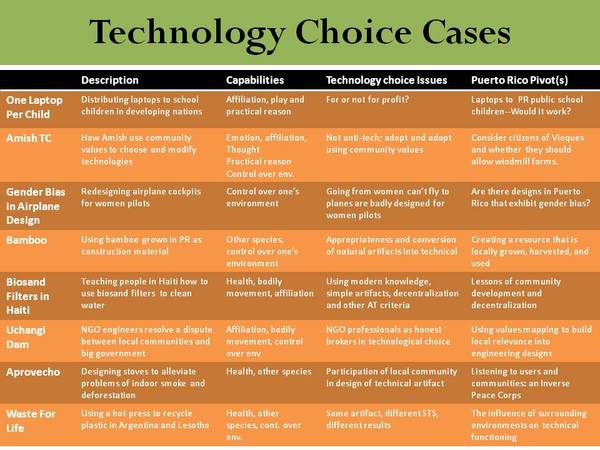-
Home
- Business, government, and society
- Responsible choice in appropriate
- Responsible choice for appropriate
V. case table
This table updates the technology choice cases used in this module.
Technology choice cases

Vi. instructions for poster session
In this activity you will carry out the following tasks:
- Read carefully the article that presents your case study in technological choice. Prepare an outline.
- Prepare a poster that discusses your case in terms of the following framework.
-
Zoom in . Describe and classify the artifact that highlights your case. Give its physical structure, how it functions when it is working properly, and its "user manual."
-
Zoom out . Describe the socio-technical system that surrounds your artifact by constructing a table that outlines hardware, software, physical surroundings, people/groups/roles, procedures, laws, and information systems. Pay special attention to how the surrounding STS constrains and enables the functioning of your technical artifact.
-
Discuss/Evaluate how "appropriate" your technical artifact is to its surrounding environment. Is it "supportive of production by the masses," does it make use of the "best of modern knowledge and experience," does it trend toward "decentralization," does it fit in with the "laws of ecology," is it "gentle in the use of scarece resources," and does it serve human rather than constrain humans to serve it."
- How does your technical artifact stand in relation to Nussbaum's list of
capabilities ? Most importantly, does it serve as a tool to address personal, social, and environmental conversion factors that help convert capabilities into functionings?
Close-out writing assignment
- Choose a technical artifact from another group's poster. (Not the one prepared by your group.)
- In one or two sentences, describe what is happening when the technology is fully functioning. This is called
"zooming in."
- Next, choose the two elements of the surrounding socio-technical system that most effect this technical artifact and its functioning. For example, the lack of electricity in communities in Zimbabwe have a strong impact on whether and how podcast broadcasts will take place.This focusing on the socio-technical system will help you to
"zoom out."
- Choose a capability from Nussbaum's list that is pertinent to the technical artifact you have chosen. Does this artifact serve as a conversion factor that converts the capability into a specific functioning? What personal or environmental factors could effect this conversion?
- Formulate a test question (multiple choice format) that you think would arise from this group's poster and their technology choice case.
- Zooming in and zooming out comes from Ilse Oosterlaken and can be found in
The Capability Approach, Technology and Design , Ilse Oosterlaken and Jeroen van den Hoven, eds. New York: Springer, 2012.
Vii. what have you learned?
- Technological choice is as much a skill as a set of concepts that you learn. This module has given you the opportunity to practice frameworks of technological choice in the context of real world cases. To help you capture what you have learned, reflect on the following questions:
- How does practicing technological choice help us to see technologies less as isolated objects and more as enactments?
- Using your case and the cases presented by the other groups in class in what sense and to what extent is the nature and structure of technology determined or constituted by social structure?
- Again, working with the cases studied in the module, under what conditions can technologies escape our control and, in turn, control us?
- What are the features and uses of a good, concrete STS description?
Source:
OpenStax, Business, government, and society. OpenStax CNX. Mar 04, 2014 Download for free at http://legacy.cnx.org/content/col10560/1.6
Google Play and the Google Play logo are trademarks of Google Inc.

